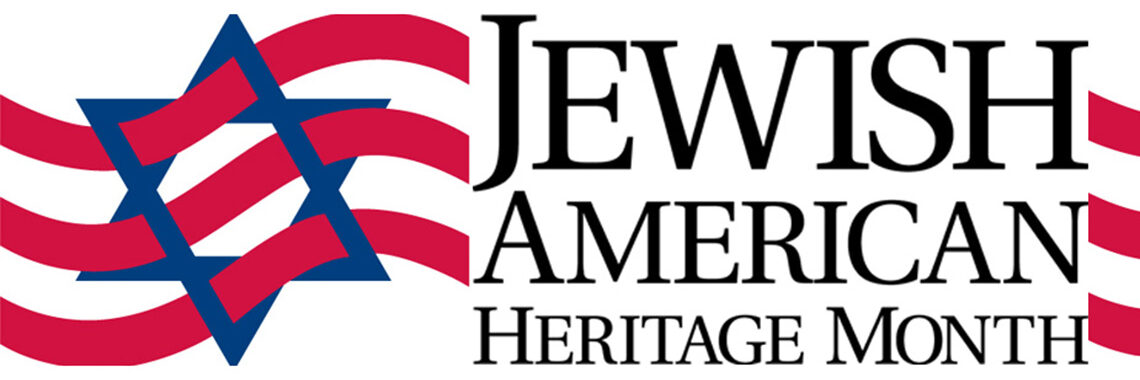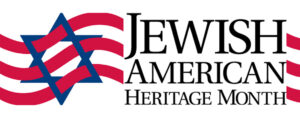By Matt Golden
Director, Jewish Community Relations Council
We have celebrated Jewish American Heritage Month in this country since 2006. This may be a little-known fact to you; it was assuredly a little-known fact to me until very recently. When the month-long commemoration was created, the goal was to “celebrate the rich history of the Jewish people in America and honor the great contributions they have made to our country.” In the 370 years since the first recorded arrival of a Jewish person to these shores in 1654, there is no question that a tiny population of Jews—never larger than it is now at around 2%–has contributed mightily to this country’s success.
When we speak about those contributions, we usually speak in terms of individual leaders who made a difference by their example. People like Francis Salvador, the first Jew ever elected to hold public office in the colonies and the first Jew to die, in August 1776, fighting for the Continental Army. Or Colonel Solomon Bush, the highest-ranking Jewish officer of the Revolution, who became the first Jew to join a Quaker abolitionist society to oppose slavery in 1782.
Let me say that I enjoy these historical anecdotes that accompany the now 18-y,ear-old Jewish Heritage Month. As someone who enjoys history, I find meaning in studying Jewish people like Salvador and Bush from the birth of this country. But since the JHM commemoration is now 18 (and old enough to vote), I vote that we try to begin to think about it in a new way. Jewish heritage doesn’t need to be “long ago” or “far away” — it should be part of the fabric of who we are. In short, for this month-long celebration to have meaning, we need to localize, we need to internalize, and we need to observe Jewish Heritage it in our midst.
First, let’s localize. Think about Max Nahm, a former chair of the Federal Reserve Bank here in Kentucky who helped convert Mammoth Cave into a National Park. Or while we’re on parks, Isaac Bernheim, who donated one of the largest parks in our region for the benefit of this area. Then there’s Adele Brandeis, an art administrator who helped preserve the art of Shakertown. Or Stephen Frank, a Jewish pioneer who died in the city that would become our state capital and who gave the place its name. So, if you go to Shakertown, or Frankfort, or Mammoth Cave or Bernheim during May, you can celebrate a little Jewish heritage, locally.
Then, let’s internalize. Lewis Dembitz, a Louisville City Attorney was a Kentucky delegate sent to an 1860 political convention to abolish slavery and pick a presidential candidate. The candidate chosen? A young man named Abraham Lincoln who was also Kentucky-born. Dembitz’s nephew, Louis Brandeis, also a Louisvillian, would become our nation’s first Jewish Supreme Court Justice and one of the most fervent protectors of civil rights in American judicial history. Similarly, Rebecca Rosenthal Judah—whose placard appears outside our Trager Family JCC campus and whose family still lives in Louisville—worked to gain Louisville women the right to vote. Or Suzy Post who strove to guarantee rights for others during the civil rights movement as executive director of the Kentucky ACLU. Or living treasure John Rosenberg, a holocaust survivor who protected the rights of Eastern Kentuckians through the Appalachian Research and Defense Fund. So, many of the rights and freedoms we enjoy and that are a core part of our identities, were shaped in one small part or the other by a Jewish person from right around the corner. They impacted us.
Finally, let’s be a little more observant. When some people think about Jewish Heritage, I am afraid that they do not see it as a living legacy happening all around them. They are not seeing the contributions being made by local Jewish leaders right now, in this minute, who are shaping the institutions from a Jewish lens. We should do a better job in honoring them by simply opening our eyes. For that very reason, I am going to describe just a few of these folks without even naming them; you do them the honor of finding out who they are and to the Jewish Heritage that they have made and are making.
Some are easy to identify, we have a Mayor, Lieutenant Governor and Presidential Cabinet Director that you can find many days pedaling away on a stationary bike. But we also have a guy on the pickleball courts who led the Covid vaccination initiative for our city during the worst epidemic of our lifetime. There’s the former judge who enforced desegregation in our schools who attends our Federation programming. Then there’s the person on our walking track, who, along with his wife, is helping keep the future of journalism alive at a Kentucky school that neither of them went to—this after a career advocating for First Amendment rights. Or the Kentucky prosecutor that made it her mission to protect the rights of the mentally infirm. Or the woman who spent the last decades advocating for exploited children right here in Louisville. Or the several women who are presently leading national Jewish organizations. These are local folks right here, right now, Jewish leaders who make Jewish heritage a living entity. There are so many that this small list does not do them justice.
As I said before, I had no idea that Jewish American Heritage Month was a “thing.” So here is how I would ask that you celebrate it: localize it, internalize it, and be observant of those that are making our Jewish heritage as we speak. And if you would be so kind, do not be afraid to share with me some of the local Jewish leaders who have made, or are making, a difference in your life right now.
Matt Golden is a lawyer and the Director of the Jewish Community Relations Council. In his opinion, the JCRC is the most august body in the Jewish Community, seeking justice and doing tikkun olam. He is admittedly very partial and biased in this regard. He invites comments, suggestions or good stories at mgolden@jewishlouisville.org.




